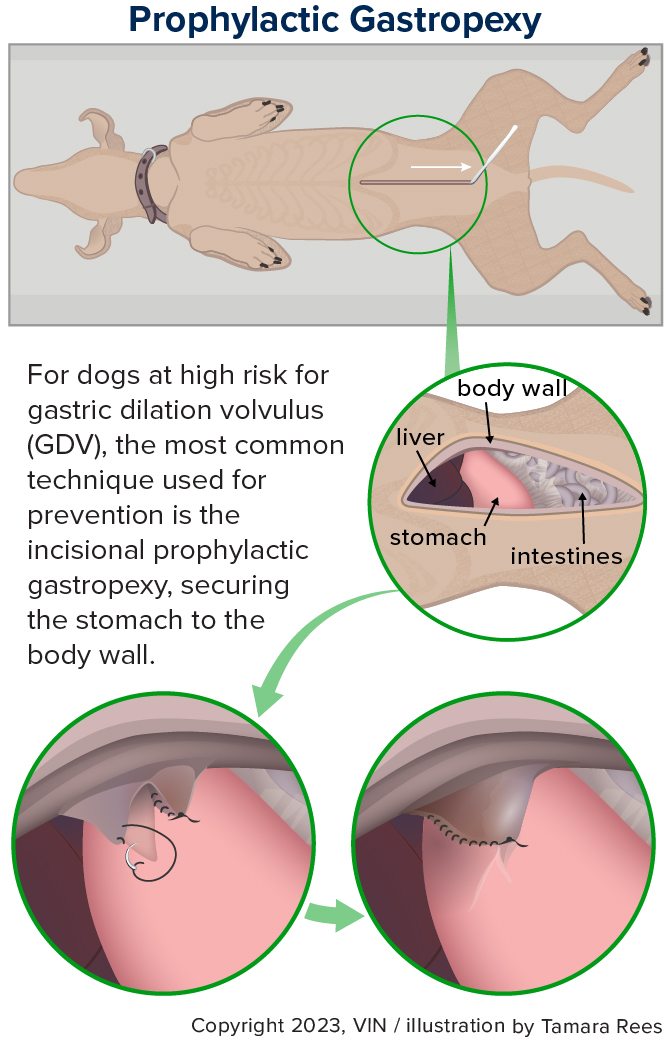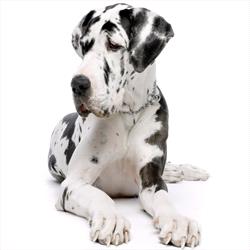Commonly referred to as volvulus, bloat, gastric dilatation, or gastric dilatation and volvulus (GDV), is an often fatal emergency that causes the dog’s stomach to distend and twist.
Two main risk factors for GDV are anxiety and a dog's body shape. GDV can happen to any breed of dog but tends to occur in deep, barrel-chested dogs such as Great Danes, St. Bernards, greyhounds, German Shepherds, Weimaraners, boxers, etc. Great Danes have the highest lifetime risk at about 40%.
When gas and food distend (stretch) the dog’s stomach to several times its normal size, the dilated (distended) stomach usually rotates. We don’t know why it twists, but it can rotate anywhere from 90° to 360° degrees (essentially from one-quarter of a circle to all the way around). When it is twisted shut, it is like a balloon tied off with a knot: unless the balloon pops, nothing is getting out. Whatever is in the stomach (food, water, gas) cannot move into the intestines. The distended stomach crushes major blood vessels in the abdomen.
Without treatment, a dog with GDV will experience significant pain and die within hours (it’s not the same time frame for every dog). For those owners who choose not to go with surgery to correct the GDV, the decision to euthanize must be made quickly because of the pain the dog is experiencing.
vp_prophylactic_gastropexy

Gastric dilatation and volvulus (GDV) is an emergency that requires surgery and hospitalization or euthanasia.
What is Prophylactic Gastropexy?
An elective surgical procedure called prophylactic (or preventative) gastropexy (tacking) prevents GDV. In deep-chested dogs or those whose adult weight is expected to reach over 99 pounds (45 kg) this preventive surgery that permanently attaches (tacks) their stomachs to the body wall is often done when a dog is being spayed or neutered, or another surgery is taking place where the abdomen is being explored already.
Gastropexy can be done when the dog is six months or older. It also can be an elective procedure on its own, or it can be done as part of treatment at the emergency room during an episode of GDV.
Types of Prophylactic Gastropexy
Prophylactic gastropexy is performed by a veterinary surgeon. Two incisions are made in the body wall, where the stomach is to be tacked, at the same spot from both the outside and inside. Sutures attach the stomach to the body wall at this spot. The scar tissue created from the two incisions will hold the stomach in place.
Laparoscopic and endoscopic gastropexies are also possible and tend to heal faster than the method described above, but they require specialized equipment that may be available only at specialty hospitals.
Laparoscopic gastropexy involves inserting instruments and a camera through two small incisions in the body wall. The endoscopic approach inserts the instruments and a camera through the mouth and esophagus into the stomach and needs only one incision.
The laparoscopic and endoscopic procedures are less invasive and take less time to heal (around two weeks), so they are often used on working dogs such as police or military dogs that need to be back in action as quickly as possible. These procedures also shorten the time the dog is under anesthesia.
What Happens After Gastropexy Surgery?
Excess gas can still be a problem, but tacking significantly reduces the stomach’s ability to twist. If the stomach becomes distended, it’s unpleasant and painful but not fatal. Unfortunately, the preventive procedure is not a complete guarantee that the dog will never have a twisted stomach, but with gastropexy surgery, the possibility of twisting drops to approximately 6%.
sitting great dane

Great Danes are one of the breeds susceptible to bloat.
Elective vs. Emergency Prophylactic Gastropexy - Aftercare and Outlook
Aftercare for preventive surgery is relatively simple. Post-operative care is essentially the same as an ovariohysterectomy (spay), and instructions will be to keep the dog calm and leashed for seven days. Do not let the dog jump or run, and keep the incision dry.
A prophylactic gastropexy can be done in dogs whose owners plan on doing competitive agility. Some agility handlers have worried that the strenuous activity of agility will break down the tacking, but there have been no studies or patient case reports that indicate that. Activity or breeding will not make the tacked stomach any less effective.
Surgery in an emergency setting requires more aftercare but depends on the dog’s case. Most patients will stay in the hospital for a few days. Their diet might need to be changed along with the usual post-operative care.
In dogs with GDV, gastropexy reduces recurrence to less than 5%, while not doing one results in recurrence rates as high as 80%.
A risk vs. benefit study calculated the lifetime risk of bloat and its medical treatment. The study found preventive surgery made sense for at-risk breeds, especially Great Danes.
If your dog is not a predisposed breed or mixed breed and does not have other risk factors for GDV, you can discuss with your veterinarian if a prophylactic gastropexy is advised/necessary. If you do have a large breed dog and/or other risk factors and have concerns about bloat, talk with your veterinarian about the potential benefits and risks of gastropexy to see if it is a good option for your dog.